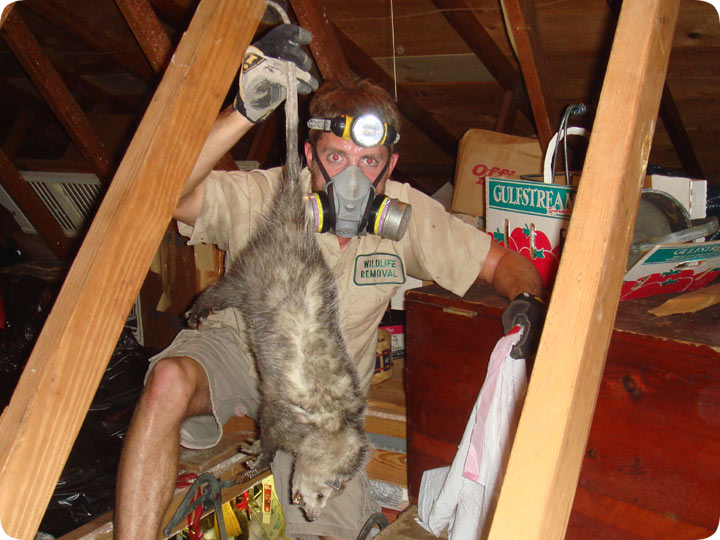-
info@aaanimalcontrol.com
Call us for help in your town
Humane Wildlife Education
Dead Opossum Below Attic Floorboards

In this case, I entered the attic, and smelled it right away. Thus, I knew that it probably wasn't a rat. Rats tend to die under the insulation, and the smell permeates the home through the drywall ceiling, but the smell does not disperse throughout the attic. I also knew that the odor was not a squirrel, for dead squirrels tend to have a more "spicy" stink, than the fouler animals. My nose led me left, my nose led me right, and soon I looked under the floorboards in the attic, and sure enough, there was the source - if it was a rat, it was a world's record. Of course, it was not a rat, but a large lookalike, an opossum.
Usually, once I spot the carcass, it's a simple matter of bagging it and spraying down the area. It's the finding that's the hard part. Not in this case. The animal was stuck far beneath the floorboards, and as always, bloated to the point that it was wedged in. Thus, I had to grab the trusty hammer (I had no crowbar) and pry up the floorboards. Once I did so, it was easy pickings. I sprayed the area, hammered the floorboard back down, and like magic, the "rat smell" disappeared.
So if you have a dead animal stink in your home, be aware that it might be any of a number of animals, and that it is usually very difficult to get to. And even once you get to it, removing it, along with maggots and juices and stuff like that might not be your cup of tea. But it is my cup of tea, my delicious soothing dead carcass cup of tea. I don't quite know why I like dead animal removals. I think they're just so low-down-dirty and degrading that I rationalize it all in my own head - how did a former child prodigy with unlimited artistic ability come to this? Of course, pulling dead animals out of homes certainly beats software development. Man, THAT was a stinky job.
Do it yourself: Visit my How To Find and Get Rid of Dead Animals page for tips and advice.
Get professional help: Visit my Nationwide Pro Directory of dead wildlife removal experts.
For more wildlife stories, click my Wildlife Blog or click my below banner to hire a local trapper.

The opportunistic opossums can invade your property anytime. Mostly, female opossums move in with baby opossums to find shelter. Moreover, being excellent climbers, they can climb into the attics, under elevated homes, porches, deck, sheds, etc. When an opossum dies below the attic floorboards, trapping and frightening strategies won’t work. And if you have been unaware of its presence before, the stench of the dead animal will bother you as its carcass starts to rot.
How to Remove Dead Opossums from the Attic?
Apart from eating your pet’s food, breaking into your attic, turning over the trash cans, depositing feces in pools or yards, and spreading diseases, the nuisance animal can leave a terrible smell upon dying.
Whether it’s the stinky stench of a dead baby possum that has fallen from the attic and died or an adult possum, both are tricky to be removed. Unlike dead rats that leave a permeating smell past the ceilings or squirrels with a ‘spicy’ stink, opossums have a terrible ‘one-spot’ smell.
To remove dead opossums here’s what needs to be done:
Locate the Possum: Usually, professional wildlife removers can easily locate the nocturnal critter hiding somewhere beneath the floorboards. If you are doing it alone, follow the stink, and locate the dead animal. Be sure to keep your pets and children away from the area.
Remove and Bag the Carcass: Carefully pick up the dead animal using protective gear and any tools you think you may need to get it out of the floorboards. Bag it in garbage bags and then double bag it. Don’t overlook the surrounding maggots and juices eating away the dead carcass. The most difficult part of possum removal is the smell. This makes it difficult for anyone to remove the dead possum.
Deep Clean and Repair: Now that you have removed the dead opossum, deep clean the area with cleaners and deodorizers. Possums can leave behind a great number of droppings, hair, urine, food, oils, nesting materials, etc. These can attract insects and other pests that may break into your attic after a possum. Moreover, there can be a stinky odor in the surroundings due to such debris. Therefore, use deodorizers to remove the foul odor. Properly complete repairs in case the resident critter has caused some trouble around the attic area.
Seal the Entrances: Inspect the surroundings for any holes and eaves that are damaged allowing critters in. Seal all the damaged or open holes, vents, etc. to prevent trouble in the future.
When to Get Professional Help?
If the horrible possum smell doesn’t allow you to enter the attic or you have failed to locate the dead animal, allow the experts to do their job. Removing the dead animal on your own can leave room for infections and diseases. In comparison, the wildlife removal experts know how to bag the carcass, clean up the area, do the repairs, and leave your attic fresh-smelling as well.




















